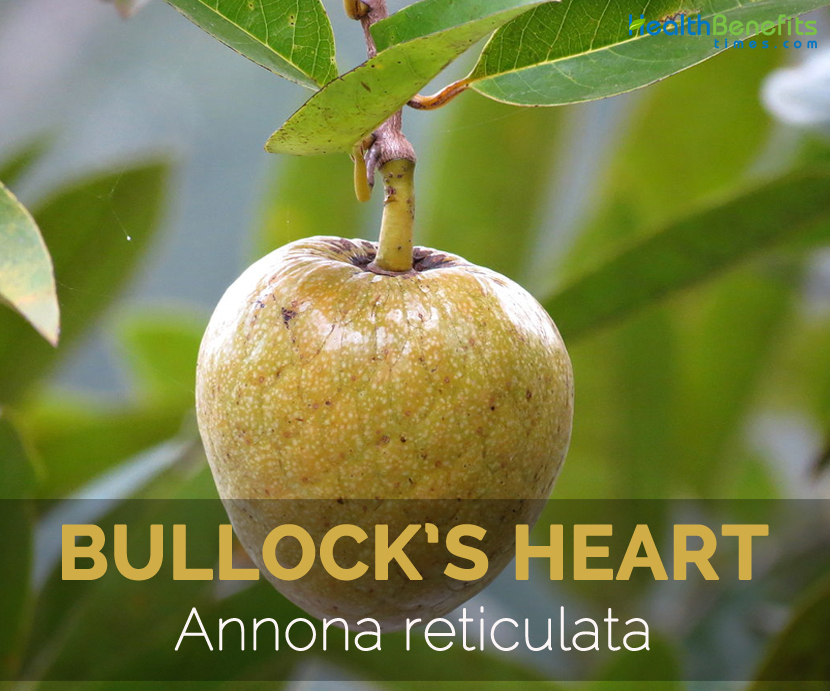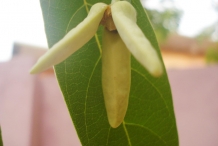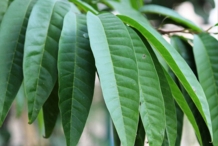| Bullock’s Heart Quick Facts |
| Name: |
Bullock’s Heart |
| Scientific Name: |
Annona reticulata |
| Origin |
Native to West Indies, possibly in Antilles |
| Colors |
Reddish brown or red (Fruit) |
| Shapes |
Ovoid to cordate, smooth, 10–15 × 7.5–12.5 cm (Fruit) |
| Flesh colors |
White or cream |
| Taste |
Mildly sweet |
| Calories |
101 Kcal./cup |
| Major nutrients |
Vitamin C (21.33%)
Carbohydrate (19.38%)
Vitamin B6 (17.00%)
Iron (8.88%)
Potassium (8.13%)
|
| Health benefits |
Treats common cold, Vasodilator activity, Treats cancer, Balance hormones, Skin health |
| More facts about Bullock’s Heart |
Bullock’s Heart is the fruit of Annona reticulate of species Annona which is generally thought to be native of the West Indies, possibly in Antilles. Bullock’s heart prefers warm and tropical climates with low lying, deep and rich soil. The plant has the trunk diameter of 25-35 cm having light yellow inner bark. The fruits are ovoid to cordate in shape with mild sweet white flesh. The seeds inside the fruit are numerous, compressed and glossy. Each fruit weighs about one or two pounds.
Other names of Bullock’s heart are: Bullock’s heart, Common Custard Apple, Custard apple, Jamaican Apple, Ox heart, Bull’s Heart, Sweetsop and Netted Custard Apple. This fruit have the nutrients such as vitamin C, carbohydrate, vitamin B6, iron, potassium, vitamin B2, Vitamin B, total dietary fiber, magnesium, protein and others. It is used to treat diarrhea, dysentery, cold, fever, stress, anxiety and other health ailments. It is believed to possess anti-inflammatory, vermifuge, astringent, tonic, analgesic, anthelmintic, wound healing, antipyretic and cytotoxic properties.
Plant
Bullock’s Heart is a small, erect, semi-deciduous or semi-evergreen tree reaching 3-10 m high with trunk diameter of 25-35 cm. The leaves are distichous, alternate, simple, coriaceous, oblong to lanceolate, 10-20 cm long and 2.5-3.5 cm wide. The bark is light brown and inner bark is light yellow. The fruit are ovoid to cordate, smooth and 10–15 × 7.5–12.5 cm in size. Bullock’s Heart is normally heart shaped with reddish brown or red color and thin or tough skin. The flesh is white or cream that bears 50 to 75, oblong and smooth seeds. The flesh have sweet and pleasant flavor.
History
Bullock’s Heart is native to West Indies, possibly in Antilles. But in the early times, it was shifted to Southern Mexico through Central America. It was and naturalized and cultivated as far South as Brazil and Peru. It is commonly cultivated in Bahamas and rarely in Bermuda and Southern Florida. It was introduced in Asian and African countries many centuries ago.
In the 17th century, it was probably introduced in tropical Africa. In South Africa, it was cultivated in South Africa as dooryard fruit tree. In India, it was cultivated around Calcutta. It is typical on the East coast of Malaya, Southeast Asia and Philippines. It was naturalized eighty years ago in Guam. It is not so much familiar in Hawaii.
Nutritional Value
100 grams of Bullock’s Heart possess the nutrients such as: 101 calories, 1.7 grams of Protein, 0.6 grams of Fat, 25.2 grams of Carbohydrate, 2.4 grams of Fiber, 30 mg of Calcium, 21 mg of Phosphorous, 0.71 mg of Iron, 0.08 mg of Thiamine, 0.1 mg of Riboflavin, 0.5 mg of Niacin, 19.2 mg of Ascorbic acid and 0.135 mg of Pantothenic acid.
Health benefits of Bullock’s Heart
Bullock’s heart helps to enhance the immune system, maintains skin health and repairs the cuts and wounds. It is rich in potassium that helps to balance electrolyte and promotes the growth of muscles. This fruit is very beneficial to the health. It is rich in Vitamin C and riboflavin. It helps to eliminate the free radicals from the body. Additionally, Bullock’s heart maintains the eye health and enhances eye sight.
- Treats common cold
Vitamin C helps to promote the immune power of the body that helps to prevent the coughs and colds from the body. It stimulates the iron absorption and promotes the resistance power of the body against infection. It also counteracts the viruses.
- Vasodilator activity
Vitamin C helps to dilate the blood vessels in the case of high cholesterol, atherosclerosis, congestive heart failure, high blood pressure and angina pectoris. The result shows that Vitamin C supplement helps to enhance the dilation of blood vessels and prevent the cardiovascular problems.
- Treats cancer
One could minimize the chances of cancer by increasing the intake of fresh fruits and vegetables. The studies shows that high intake of Vitamin C helps to reduce the chances of cancers of mouth, lungs, throat, vocal chords, rectum, colon, esophagus and stomach.
- Balance hormones
Vitamin B6 helps to treat various emotional disorders which are caused due to the deficiency of this Vitamin. The unbalance in the hormones and its formation results in emotional disturbances. Vitamin B6 is essential for treating the emotional disorders and hormones.
- Skin health
Vitamin B6 helps to maintain the skin health of humans. It helps to treat various skin ailments such as dandruff, eczema, hair loss, acne and dry skin. In addition, it also treats psoriasis and melanoma.
- Kidney and cardiac ailments
Vitamin B6 helps to control fat which are deposited on the human heart. It also prevents the cardiac ailments. Vitamin B6 also prevents the formation of kidney stones and also maintains the shape of this organ in the body.
- Forms hemoglobin
Iron assists in the production of hemoglobin. Iron provides the dark red shade to the blood and helps to transport the oxygen to the various cells of the body. Extra hemoglobin is essential because humans lose the blood in various injuries externally or internally. Women lose the blood during menstruation so they are have high chances of getting anemia. (1) (2)
- Muscle activity
Iron is essential for the maintenance of good health of muscles. It is found in the tissues of muscles and supplies the oxygen that helps to contact the muscles. Without the presence of iron the muscles lose the elasticity and tones. The symptoms might be the weakness of muscles. (3)
- Function of brain
Iron assists in the brain development. It transports the supply of oxygen in the blood and approximately 20% of the oxygen is used by the brain. It enhances the proper flow of blood to the brain that promotes the cognitive function and assists to form the neural pathways. It helps to prevent the cognitive ailments such as Alzheimer’s disease and dementia. Due to this proper intake of iron and oxygenation is very necessary. (4)
- Muscle spasms
The deficiency of iron is the major cause for the restless leg syndrome. The low amount of iron in the blood is the cause for this condition. The high intake of iron supplements helps to cure this problem. It is associated to muscle spasms which is one of its deficiency symptoms. (5)
Traditional uses
- Bullock’s heart is used in Indian folk medicine as anti-inflammatory and vermifuge agents to heal the wounds, as antimalarial for treating diarrhea and dysentery.
- The bark is an effective astringent and is provided as a tonic.
- The plant is used as anti-inflammatory properties to treat anxiety and stress.
- The decoction made from root is used as a febrifuge.
- The root bark is used around the gums to provide relief from toothache.
- The crushed leaves or flesh’s paste are used as a poultice on abscesses, boils and ulcers.
- The boiled bark, leaves and green fruits in a liter of water for about five minutes makes a potent decoction.
- The paste made from leaves is used in boils, external and internal wounds.
- The leaf decoction is used to treat gastritis.
- The internal use of leaves helps to treat worms.
- In Malaysia, Malays and Chinese used the bark as a tonic effect.
- The tea which is made from roots helps to treat fevers.
- The crushed leaf helps to cure sprains.
- The fruits are used as coolant, expectorant and stimulant.
- Its consumption helps to treat anemia.
- It also effectively treats diabetes.
- In some countries, the fruit is used as a hair tonic.
- The crushed leaves help to treat hysteria, dizziness and nausea.
- The leaves helpful for broken, swollen and sprain ankles.
- The leaf decoction helps to enhance the healthy blood flow during the menstruation.
- The decoction also provides relief from cold and fever.
- The juice of unripe Buck’s heart helps to treat insect bites.
- The decoction made from leaves should be added to bath water which helps to provide relief from rheumatic pains.
- The crushed leaves help to prevent dizziness and fainting spells.
Precautions
- The seed kernels are considered harmful.
- The seeds, young fruits and leaves possess an insecticidal effect.
- The sap of the branches can be irritant and injure the eyes severely.
- Due to its cold nature, it should not be consumed in high amounts as it could make sick.
- This fruit is rich in sugar, so the diabetic patients should not consume Bullock’s heart in high amounts.
- Those who are allergic to Bullock’s heart should avoid it.
How to Eat
- The fruit is served with sugar and light cream.
- It is also added to custards, milk shakes and ice cream.
- The ripe fruit are consumed fresh or used for juice, sauce, puddings and ice cream.
Other Facts
The crushed leaves are used in West Indies as a blue to black dye and also used as tattoo ink.
References:
http://www.phytojournal.com/archives/2013/vol1issue5/PartA/1.1.pdf
file:///C:/Users/drchi_000/Downloads/article_wjpps_1396445286.pdf
http://shodhganga.inflibnet.ac.in/bitstream/10603/14136/9/09_chapter%202.pdf
https://books.google.com.np/books?id=tixF72IuRFwC&pg=PA205
http://ntbg.org/plants/plant_details.php?plantid=606
http://tropicalfruitfarm.com.my/pdf/Bullock-Heart-k.pdf
http://www.medicinalherbs-4u.com/custard-apple-leaves.html
http://tropical.theferns.info/viewtropical.php?id=Annona+reticulata
http://www.tipdisease.com/2014/12/benefits-and-nutrition-of-custard-apple.html
http://ntbg.org/plants/plant_details.php?plantid=606
http://www.tipdisease.com/2014/12/benefits-and-nutrition-of-custard-apple.html
https://www.organicfacts.net/health-benefits/vitamins/health-benefits-of-vitamin-c-or-ascorbic-acid.html
https://www.organicfacts.net/health-benefits/vitamins/health-benefits-of-vitamin-b6-or-pyridoxamine.html
http://www.aihd.ku.edu/foods/custard_apple.html
Comments
comments





